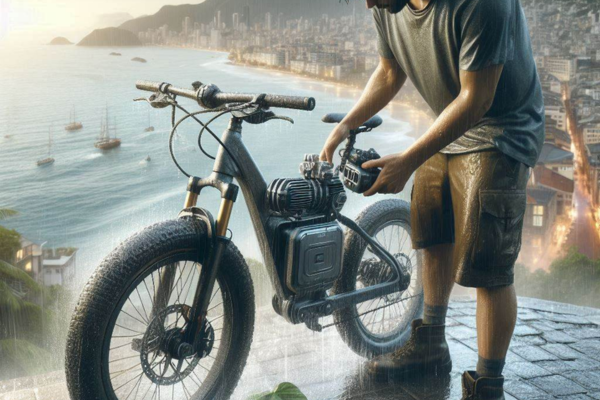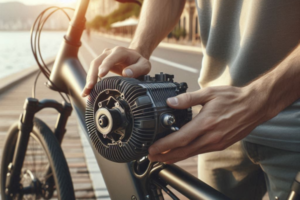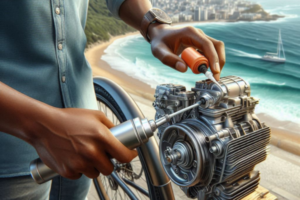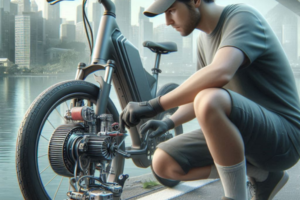The Waterproof Motor Solutions for Electric Bicycles in Humid Climates
🌧️ When Water Meets Wires: Why Humidity is the Enemy of E-Bike Motors
Electric bicycles are revolutionizing urban mobility, especially in warm and coastal regions. But in humid climates, where moisture saturates the air year-round, the motor — the core of your e-bike’s power — is under constant attack. Water and electronics don’t mix, and the longer your motor is exposed to high humidity, the more likely it is to suffer degradation, performance loss, or even failure.
While occasional riders might not notice the signs, daily commuters and delivery cyclists in cities like Bangkok, Lagos, Rio de Janeiro, or Miami know all too well the hidden risks of a “wet” environment. Humidity creeps silently into seals, connectors, and internal components. It corrodes, rusts, shorts, and weakens — often before the damage is visible from the outside.
This is where waterproof motor solutions come in. These are not just clever marketing terms — they’re critical technologies designed to insulate, repel, and protect the electrical heart of your ride from one of nature’s most persistent threats.
🧪 What Humidity Really Does to Your Motor
Humidity doesn’t usually flood your motor. Instead, it does something worse: it lingers. When humid air meets a warm motor casing, condensation forms inside. Over time, this leads to:
- ⚠️ Corrosion of copper windings and magnets: Essential for power generation, these components are highly sensitive to moisture exposure.
- ⚠️ Connector degradation: Moisture around connectors creates weak electrical signals, resistance, or outright failure.
- ⚠️ Seal deterioration: Seals wear faster when they’re constantly expanding and contracting from humidity and heat.
- ⚠️ Internal rust: Bearings and screws inside the motor casing can oxidize, creating drag, noise, and early mechanical failure.
These effects might not happen overnight. But they do happen — especially in tropical zones where riding conditions shift rapidly from sunny to steamy to soaking wet. The motor might still function, but its performance will fade, and its lifespan will shorten dramatically without intervention.
💡 A New Era: Waterproof Motor Technology
The good news is that motor manufacturers have responded to these challenges with specialized waterproofing techniques. We now live in an era where water resistance isn’t optional — it’s essential. IP-rated enclosures, waterproof connectors, and internal insulation materials have changed the game.
But not all waterproof solutions are equal. Some are designed for light rain protection. Others are ready for the harsh, salty, and wet realities of humid cities. Knowing the difference — and choosing the right level of protection — is the key to worry-free riding.
💬 A Moment to Reflect
“You can’t stop the rain — but you can choose a motor that rides through it.”
In the next sections, we’ll break down the best waterproof motor technologies available, compare their strengths, and help you understand exactly what kind of protection your climate demands. Because in humid environments, preparation isn’t just smart — it’s survival.
🛠️ Essential Technologies That Make E-Bike Motors Truly Waterproof
When it comes to protecting electric bicycle motors in humid climates, not all waterproofing is created equal. Many riders assume that a “sealed motor” means full immunity from moisture, but the reality is more nuanced. True waterproofing requires a strategic combination of materials, design, and manufacturing practices. In this section, we’ll uncover the most important waterproof motor technologies and how they work together to offer long-lasting protection.
🌊 1. Advanced IP-Rated Motor Casings
IP ratings (Ingress Protection ratings) are the global standard for measuring how well a device resists intrusion from solids and liquids. For e-bike motors in humid climates, an IP rating of at least IP65 is recommended — this protects against dust and water jets. However, for cities with consistent high humidity or coastal exposure, an IP67 or IP68 rating is ideal, as these provide protection against temporary or continuous submersion.
🔌 2. Waterproof Connector Systems
Even the most tightly sealed motor can be compromised if the connectors are vulnerable. Waterproof connectors — such as those made by Higo or Julet — include silicone gaskets, O-rings, and even threaded locking systems to ensure a watertight seal. These connectors are commonly used in marine applications, making them perfect for electric bicycles in tropical and coastal regions.
🧴 3. Internal Moisture Control and Anti-Corrosion Coatings
Some motor manufacturers go beyond external sealing and apply specialized coatings to internal components. This includes dielectric layers on copper windings, rust inhibitors on bolts, and hydrophobic membranes that absorb residual moisture. These inner shields reduce the risk of short circuits, performance drop, or oxidation over time — even in extreme humidity.
🌡️ 4. Temperature Regulation and Passive Venting
In hot, humid climates, temperature spikes can increase internal condensation. To counteract this, high-end waterproof motors integrate passive ventilation or heat dissipation channels. This regulates internal temperature, preventing the kind of pressure and vapor build-up that leads to corrosion or premature failure.
📊 Comparative Table: Basic vs. Waterproof Motor Technologies
| Feature | Basic E-Bike Motor | Waterproof Motor Solution |
|---|---|---|
| IP Rating | IP54 (splash-resistant) | IP67 or IP68 (submersion-proof) |
| Connector Type | Standard plugs | Threaded marine-grade, gasket-sealed |
| Internal Protection | None or basic enamel coating | Hydrophobic coating + rust inhibitors |
| Heat Management | Plastic casing only | Heat sinks or vented shell structure |
💬 A Thought Worth Remembering
“True waterproofing isn’t a single feature — it’s a layered system of trust between rider and machine.”
When choosing your next e-bike or upgrading components, don’t rely solely on vague terms like “waterproof” or “weather-resistant.” Look for the details that matter — IP ratings, connector quality, internal coatings — and protect your ride from the inside out. Because in humid environments, every ride starts with preparation.
🌍 Real Story: How a Coastal Rider Saved His Motor in Manila
Carlos, a delivery driver in Manila, Philippines, rides over 50 kilometers daily through humid streets, tropical storms, and sudden floods. His first e-bike had a standard motor, and after only five months, it began showing signs of distress: odd clicking noises, reduced torque, and sudden power drops. A technician opened the hub motor and found internal rust and water residue — a clear case of moisture intrusion from coastal humidity and frequent puddle splashes.
Determined not to repeat the mistake, Carlos invested in a waterproof motor with IP68 rating, marine-grade connectors, and internal anti-corrosion coating. He also began a regular care routine: post-rain cleanings, monthly connector inspections, and keeping the bike elevated at night to prevent condensation under the frame.
One year later, despite riding through typhoons and tropical heatwaves, Carlos’ motor was still performing flawlessly. His clients get their food warm, and his confidence in his ride never wavers. “I used to fear every rainy afternoon,” he said. “Now, I just ride.”
🛠️ Best Practices for Waterproof Motor Maintenance
Even with the best waterproof motor technology, preventive care still plays a major role in extending your motor’s lifespan in humid climates. Below are practical habits that require little time but provide massive protection:
- ✅ Wipe your motor casing with a soft cloth after every wet ride to remove invisible salt and grime.
- ✅ Inspect all seals and connection points weekly for signs of wear, cracks, or gaps.
- ✅ Apply dielectric grease to connectors monthly to block moisture intrusion and ensure clean electrical contact.
- ✅ Reapply anti-corrosion spray to exposed bolts or screws every 4–6 weeks, especially in rainy seasons.
- ✅ Store your e-bike in a ventilated space — avoid airtight plastic covers that trap humidity overnight.
- ✅ Run system diagnostics using any manufacturer app (if available) to monitor motor health and temperature trends.
⚠️ What NOT to Do with Waterproof Motors
Some riders assume a waterproof label means their motor is invincible — but even IP68-rated motors need care. Avoid the following mistakes to prevent long-term damage:
- ❌ Never submerge your e-bike fully — waterproof doesn’t mean submersible in all cases. Check your manufacturer’s limits.
- ❌ Don’t ignore firmware updates — they often include motor calibration improvements for environmental conditions.
- ❌ Avoid using strong solvents or degreasers near your motor casing or plugs — they can degrade seals and plastic connectors.
- ❌ Don’t store your e-bike in sealed bags or non-breathable tarps. These create the perfect condition for condensation.
💬 Wisdom from the Ride
“It’s not the rain that damages your motor — it’s the assumptions you make after it stops.”
Like Carlos in Manila, any rider in a humid or rainy climate can enjoy their e-bike fully — without fear. It just takes a little knowledge, a few good habits, and a waterproof motor that’s truly built for the environment you ride in every day.
🚫 Common Mistakes That Undermine Motor Waterproofing
Even with the best waterproof motor technology, improper care can reduce its effectiveness. Many riders in humid climates unknowingly adopt habits that compromise the motor’s protection — not because they’re careless, but because they haven’t been taught what to avoid. Understanding these mistakes is key to preserving your e-bike’s heart.
- ❌ Washing with high-pressure water: Even waterproof motors can be damaged by jet sprays, which force water past seals and into sensitive components. Always clean with a damp cloth or gentle mist, never a hose.
- ❌ Ignoring small cracks or seal wear: Over time, UV exposure and vibration can weaken seals and covers. Once compromised, even the best waterproof motor is vulnerable to moisture intrusion.
- ❌ Leaving the e-bike in direct sun and then cooling rapidly indoors: Sudden temperature changes create internal condensation — especially when paired with coastal humidity.
- ❌ Not checking connectors regularly: Waterproof connectors degrade with time. Without periodic inspection, you may miss early signs of corrosion or loosened pins.
- ❌ Using incompatible lubricants or sprays: Oils not designed for electrical components can attract dust or degrade seals — the opposite of what your motor needs.
These errors can silently reduce the effectiveness of waterproofing. But the good news is, they’re easily avoided with a little knowledge and routine attention.
📋 Preventive Maintenance Checklist for Humid Climates
Below is a weekly and monthly checklist designed for riders in tropical, coastal, or rainy areas. Incorporating these steps into your routine will extend the life of your waterproof motor and keep performance steady.
- ✅ Daily: Wipe the motor casing with a soft cloth after riding in mist, rain, or near the ocean.
- ✅ Weekly: Check motor seals, bolts, and vent covers for cracks or residue buildup.
- ✅ Weekly: Examine waterproof connectors for corrosion or signs of moisture intrusion.
- ✅ Monthly: Apply approved protective spray to motor casing and fasteners.
- ✅ Monthly: Disconnect and inspect motor-battery connections; re-grease if needed.
- ✅ Quarterly: Run a full diagnostic (if your e-bike includes a smart system or app).
- ✅ As needed: Replace worn seals or waterproof sleeves to prevent leaks.
Print this list and keep it in your garage or near your bike stand. Preventive care is easy when you have a system — and this system was built for riders like you.
💬 Reflections from the Field
“Even the strongest shield weakens without attention. Waterproofing starts with tech — but it survives through your hands.”
Your e-bike motor is engineered for resilience, but it relies on your awareness. If you live in a region where the air feels thick, the ground stays damp, and the ocean is always nearby — then this checklist isn’t optional. It’s essential. And it’s one of the most loving things you can do for your ride.
❓ Frequently Asked Questions (FAQs)
Are waterproof motors really necessary if I don’t ride in the rain?
Yes. Even if you avoid riding during storms, humidity can still infiltrate your motor. In tropical or coastal environments, moisture in the air condenses inside sealed motor housings when temperatures shift. Waterproof motors reduce the risk of internal rust, corrosion, and short circuits over time — even when the bike is at rest.
How do I know if my motor is waterproof?
Check the motor’s IP (Ingress Protection) rating, usually found in the product specs or user manual. IP67 or IP68 indicates a high level of water and dust resistance. You can also look for waterproof connectors, silicone gaskets, and sealed casing designs from trusted brands like Bosch, Shimano, Bafang, or Mahle.
Can I waterproof a motor that isn’t rated as waterproof?
To some extent, yes. While you can’t change the casing design, you can improve protection by applying anti-corrosion spray to bolts and seams, sealing connectors with dielectric grease, and covering vulnerable areas with silicone sleeves. These steps won’t make your motor submersible, but they’ll reduce everyday moisture damage significantly.
What signs indicate that humidity is damaging my motor?
Early signs include inconsistent power, longer charging times, reduced torque, or strange noises during acceleration. If left unchecked, these can lead to full electrical failure or physical corrosion inside the motor casing. Regular inspections and waterproof upgrades help avoid these outcomes.
💬 Final Thoughts
In humid climates, waterproofing isn’t a luxury — it’s a necessity. Your motor is the invisible force that powers your journey. Every mile you ride is made possible by its efficiency, strength, and resilience. Protecting it from water and humidity is not just about technical durability. It’s about honoring the road, your commitment, and your freedom to ride without fear of what the weather might bring.
Choosing waterproof solutions is choosing peace of mind. It’s knowing that even when the clouds roll in, your motor will keep turning. It’s the assurance that the ride doesn’t stop — because you’ve planned for the environment you live and ride in.
🌟 Join the Conversation
Do you ride your electric bike in a humid or coastal city? Have you upgraded your motor for waterproofing, or learned any lessons the hard way? Your story might be the one that saves someone else’s motor from damage — or encourages them to ride farther and smarter.
Leave your comments below and share your best waterproofing tips, favorite motor brands, or maintenance habits. Let’s help each other build stronger bikes — and stronger communities.
Because every ride matters. And when your motor is protected, the ride continues — no matter how humid the road ahead becomes.



